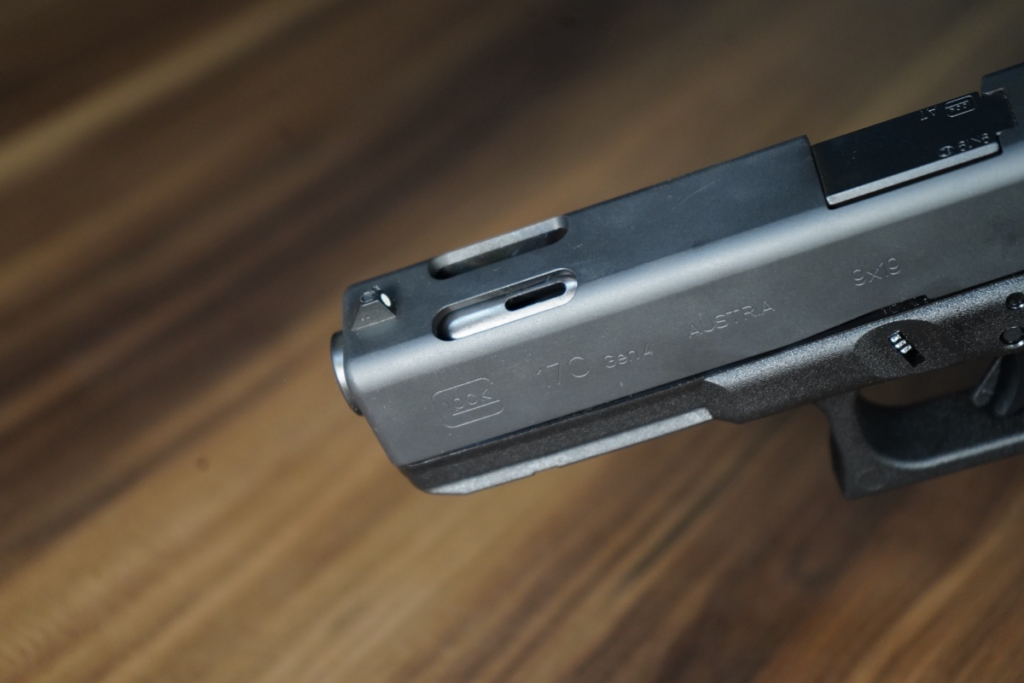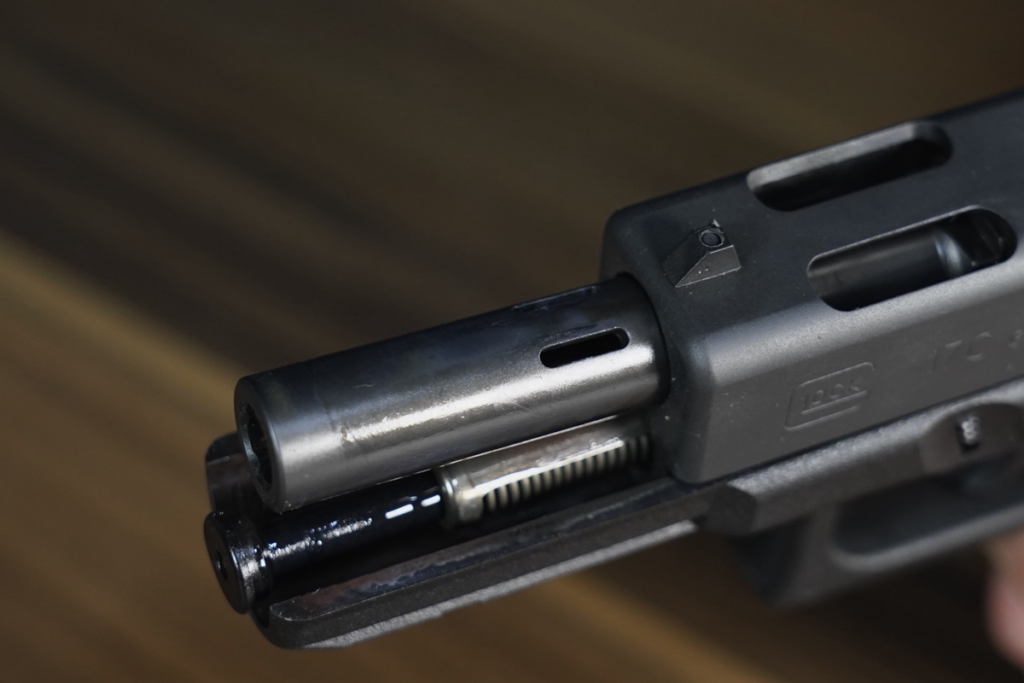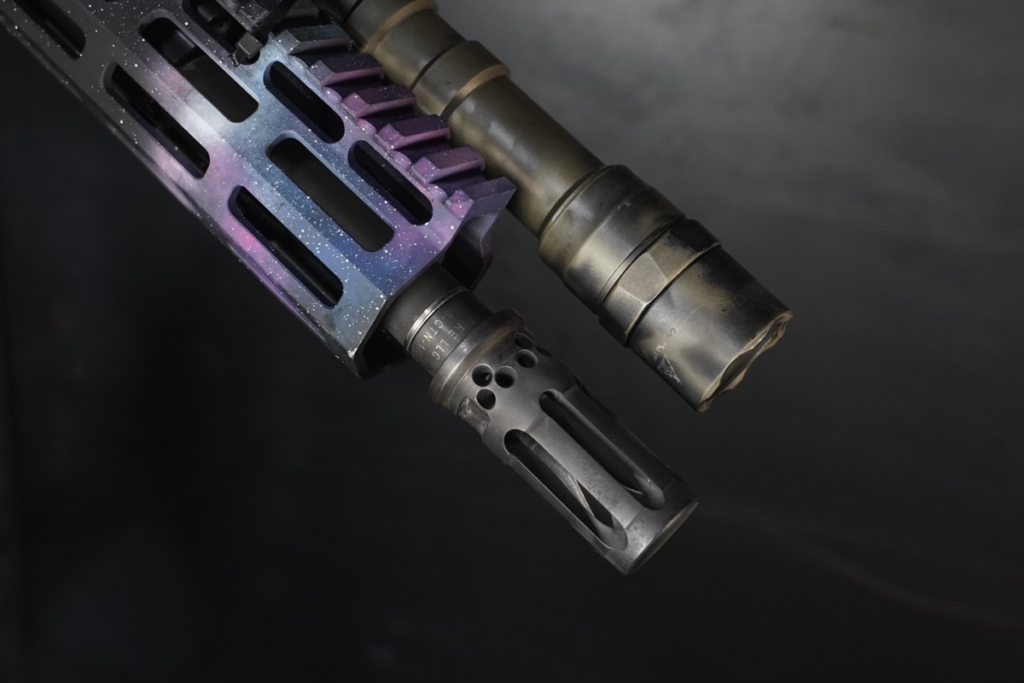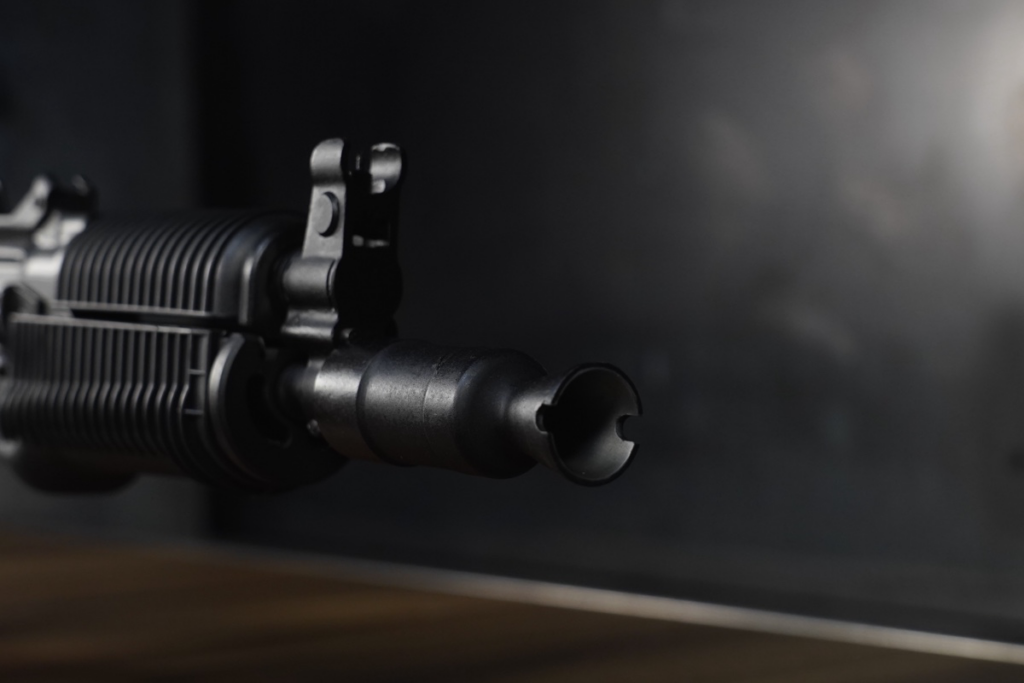
When it comes to choosing accessories for your rifle or pistol, there are many different options. Two of the most popular choices are flash hiders and muzzle brakes. Both of these devices have their pros and cons, which can make it difficult to decide which one is right for you.
In this blog post, we will discuss the differences between flash hiders and muzzle brakes. We will also talk about compensators and even touch on boosters and how they can play a role in reliability as well as how these muzzle devices have evolved to serve as mounting platforms for suppressors.
Oftentimes there is more influencing these designs than the initial primary objective. For a lot of these designs cost, ease of manufacture, size, weight, amount of engineering, and secondary objectives can come into play. And advances in material engineering and manufacturing modify these over time.
This blog post is meant to be a solid primer and not a definitive piece. I will include pictures and will have videos of night use as well.
Flash Hiders
We can trace the use of flash hiders on military issued weapons all the way back to World War II. A flash hider is a class of devices that attaches to the end of your muzzle and is engineered to help reduce the muzzle flash created by your firearm when it is fired.
While reducing flash is the primary objective for a flash hider, often it’s not the only concern that can influence the design. Often these modern flash hiders also serve as a mounting point for a suppressor. This reduction in muzzle flash is achieved by the flash hider manipulating the direction of gas and unburnt powder flow. Flash hiders can come in many sizes and designs, some more effective than others at reducing flash.
It’s also important to note that flash hiders oftentimes do not redirect the gas being expelled from the muzzle in a obnoxious way that could impact others around the person firing as muzzle. Flash hiders are also thought to be slightly quieter. Not as quiet as a suppressor but quiet in the sense that it’s not shooting off gas to the sides like some muzzle breaks. The way certain muzzle breaks redirect the gas can certainly make the shot report feel louder.
If reducing the flash from the muzzle is the goal, do not forget to choose an ammunition that has flash reducing properties. This is mostly found in defensive types as well as certain military issued ammunition. Please test each load individually to see how much flash they have.
Another variable that can impact your flash is reducing barrel length and the caliber being used. Most calibers have an optimal barrel length for full burn meaning that in said barrel length almost all the powder burns off.
This means the shorter we deviate from that optimal length for full burn the larger the potential flash. An example of this is a 20 inch ar-15 vs a 10.5 inch version. The shorter barrel length will have more of a flash from the unburnt powder. Often this unburnt powder can be attributed to muzzle flash even on pistols. This can be mitigated by selecting a powder that can be optimized to a certain barrel length.
Use cases for a flash hider
Flash hiders are selected when reducing the visual flash signature is the primary goal . This can sometimes help during certain daytime conditions but really come into play at night. This can work great for Military/ law enforcement applications, hunting, or just night shooting. Anything that benefits from not having a huge fireball coming from the end of your muzzle.
This can help to preserve your natural night vision and also helps while shooting under night vision devices. Flash hiders are also less likely to direct gasses towards those around you in an obnoxious way like most muzzle brakes do. Like when you are on a line firing together or in close proximity. Think small entry teams firing in an enclosed environment like a room. It’s important to note that in the purest form a flash hider will not have recoil reducing properties.

pre war colt ar-15
Here we can see a 3 prong design on this pre vietnam Colt AR-15. While the 3 prong design was extremely effective in reducing the flash ,the design had some drawbacks.
The open design of the tines meant that the prongs were a snag hazard and often would get hung up especially on the foliage in Vietnam. These open-tined 3 prong designs often sounded like a tuning fork. They would make a sound while vibrating on the end of the muzzle from being shot and from any small impact.
Another issue for some of these flash hider designs was that they were open all around, meaning they were venting gas in 360 degrees. This could potentially increase the amount of dust or small debris that kicked up from firing prone.
These lessons learned in the Vietnam war heavily influenced the design of the U.S. A2 flash hider. This flash hider also acts as a compensator as well, but we will cover that in the compensator section. Here are some pics of different flash hiders from some of the most iconic firearms from different time periods.

Here is a early Colt AR-15 from before the VIETNAM WAR.

Heckler & KOCH pre ban HK93 in woodland camo

Chinese Norinco NDM-86

Pre ban civilian semi auto variant of the French FAMAS

Pre Ban semi auto STYER AUG

Smith Enterprise M21 clone

Beretta AR-70 Pre Ban Semi Auto
More modern approaches to flash hiders can include closed tine designs that, unlike the open prong designs, reduce the chances of snagging and getting hung up .

Some modern open prong designs have included ways to reduce the pinging vibrations.

This can be achieved by having the prongs at different over all lengths or different individual weights to reduce the level of vibration.
Muzzle Brakes

Muzzle Breaks are a class of muzzle devices that are designed to help reduce the amount of felt recoil that is felt by the person firing. This reduction in felt recoil is achieved by the muzzle break manipulating the direction of the gas flow.
Muzzle breaks can come in many different shapes and sizes. Some are more effective than others. While reducing the felt recoil is the primary objective for a muzzle break, often that is not the only concern that can influence the design.
Some modern muzzle breaks will have a secondary objective and is usually that of a compensator. Other designs also serve as a mounting point for suppressors. It’s important to note that the use of muzzle breaks will normally increase both the sound signature as well as the flash signature, even kicking up dirt and debris during use.

The increase in noise is mostly caused by how the gasses are being redirected while passing through the body of the muzzle break. The body of the muzzle break could be comprised of chambers with angled opening to the sides where the gasses will be expelled. These concentrated jets of gas and unburnt powder being expelled cause the flash signature to increase and kick up dirt and debris while firing.
Various muzzle brake designs can have an overall impact on how effectively felt recoil is reduced. In certain cases, mostly with gas operated semi automatic/automatic firearms, it’s possible that choosing the wrong muzzle brake can negatively impact the cycling and recoil impulse.
The caliber, type of ammunition, and more importantly the velocity and bullet weight will be a large factor in how effective the muzzle break is. This applies to both felt recoil and reliability.
It’s worth noting that certain calibers just do not lend themselves to using a muzzle break with any meaningful effect. These calibers will often be low velocity like .45 ACP. As an example, if you are using the same caliber at a higher velocity, the ammunition will generate more gas that will be directed by the muzzle brake. This can increase the effectiveness of the muzzle brake.
Using a lower velocity ammunition will not and the manipulation of gas in combination with the slower velocity can negatively impact reliability. This effect can be seen even when not using a muzzle break but the muzzle break could potentially increase the possibility of potential issues.
Use Case For Muzzle Brakes
Muzzle brakes are selected when the primary goal is reducing the felt recoil during firing. Muzzle brakes can trace their lineage to the early 1900s with one of the 1st uses being in artillery.
Often this reduction in felt recoil can be a huge benefit. The use of a muzzle break will reduce felt recoil and will normally mean a faster follow up shot as the user is less physically disturbed by the recoil. This can be seen in larger and smaller calibers.
This reduction in felt recoil can also help reduce the tendency to anticipate the shot in a negative way, also known as flinching. One example is installing a muzzle break on a large caliber to help tame the felt recoil and make shooting it more pleasurable, allowing the user to be less fatigued from recoil especially during a long session.
These benefits can be very helpful in many use cases, not just for someone who is recoil sensitive. This is why muzzle breaks can be seen in certain military/law enforcement uses primarily with precision rifle applications. As well as competitive shooters trying to get an edge.
Another aspect of muzzle brakes that might be controversial, is the muzzle brake’s benefits when using a suppressor. I firmly believe from my personal experience that certain muzzle brake designs can act as a sacrificial baffle when used in conjunction with a suppressor. I believe that the brunt of the gas hitting the wall of the port on the muzzle brake first reduces the erosion on the suppressor’s blast baffle.


The use of a muzzle break on the AK-74 series by the (at that time) Soviet Union started in 1973. This is one of the most prolific uses of a muzzle break in modern military issued firearms, in my personal opinion. Like many others, this brake also has a secondary compensating effect.
Compensators

Compensators are a class of muzzle attachment that is designed to counteract the muzzle rise by essentially pushing the muzzle in a different more desirable direction. This is achieved by the compensator’s ability to manipulate the gas flow. Some compensators can even be designed to be integral to the barrel. Some designs are more effective than others, coming in all shapes and sizes.
While the primary goal of a compensator is to redirect the orientation of the muzzle during firing, often many modern compensators are designed to function as a muzzle brake. Some modern compensators can also serve as a suppressor mounting point.
The use of a compensator will normally increase both the flash and noise signature during use. This increase in noise and flash is often attributed to how the gasses and unburnt powder is manipulated into concentrated directed jets of gas. True compensator does not reduce felt recoil, but generally compensators will feature the ports at the 12 o’clock position to use the gas to drive the muzzle down during firing. These ports can be machined into the body of the compensator or directly into the barrel in some cases as seen often in pistol compensators.
Various compensator designs can have an overall impact on how effective it is and how much muzzle rise is reduced. Just Like muzzle brakes, compensators can impact the reliability of gas operated semi automatic/automatic firearms.
Compensators can cause some negative outcomes depending on their employment. Some designs can push the muzzle down too aggressively causing your sight to dip down from your point of aim. Other designs like those found on pistols, tend to foul the front sight since the compensator is located just before it.
Some compensators have a tuning ability where the user can change the flow of the gasses, tailoring the amount of compensation for the individual use case. This can be changing whether the compensator pushes down and to the left or right.
Some of the same principles that apply to muzzle breaks also apply to compensators as they have a similar operation. This means that the design of the compensator as well as caliber, type of ammunition, and velocity will be a factor that impacts not only the effectiveness but also the reliability.
Use Case For Compensators
Compensators are chosen when the primary goal is to reduce the muzzle rise. The use of compensators goes way back with one of the more prolific uses being on the Thompson sub machine gun chambered in 45 A.C.P.
Often this reduction in muzzle rise can have many benefits. The use of a compensator whether on a handgun or a shoulder fired firearm will see a reduction of muzzle rise during firing. This will directly translate to a flatter shooting experience in regards to muzzle climb.
Often this will mean faster follow up shots as well as the sight picture being disturbed less as well as the firearms sights returning sooner. These benefits that compensators provide can be useful to a whole range of users as seen from being issued on military firearms and competitive shooters’ handguns. Personal protection/defensive applications, especially on pistols, will also benefit from a compensator.
Modern compensator designs often blend muzzle brake and compensator designs into one.

This AK-47 slant brake was originally introduced in the soviet union on the AKM in around 1959. While referred to as the slant break it is very much a compensator. It reduced the amount of muzzle rise while shooting and accounted for a right handed shooter by pushing the muzzle down and to the left.

Here is a picture of a factory compensated Glock. As we can see the slide is machined to allow the gas being jetted from the barrel to escape.


This surefire war comp not only serves as primarily a flash hider but also has a secondary compensating ability where gas is jetted out of these small ports. It’s worth noting that the orientation of this device will affect how it compensates whether down and to the left or right.
Muzzle Boosters

Lastly we have the Boosters. A booster or muzzle booster is a type of muzzle attachment that’s primarily used on a gas operated firearm that needs increased pressure in the gas system. This is done by trapping the gas at the muzzle. Boosters are normally used on short barrels to increase the cycling reliability.
While increasing the pressure in the gas system is the primary objective of a booster, the way it operates can have many other benefits as well. One is lessening the concussion of the report and redirecting the gas and unburnt powder forward, away from the muzzle. It can also help lessen the flash to a degree. Keeping in mind that these are normally employed on extremely short barrels, flash and sound signature will be high.
Some boosters were developed for specific weapons, for example Colt’s 1966 muzzle booster called “the Moderator.” This was designed to increase the back pressure that was deemed necessary for reliable cycling with the short 10′ barrel 5.56 rifle. This booster design was featured on the iconic Colt XM177.
Another historical example is on the Soviet Union’s AKS-74U, first introduced in 1979 with a 8.1 inch barrel chambered in 5.45x39mm. These boosters where critical for the reliable cycling of these extremely short barrels.

While the reliability of shorter AR-15 based firearms have dramatically increased over the years due to optimizing the gas port sizing, bufferweight, and spring weight, boosters can still be found on the shorter end of the barrel spectrum such as 7.5′ in 5.56 guns.
The secondary benefit of boosters is lessening the concussion felt around the muzzle as well as a reduction in flash. Originally these short barrel lengths were designed to be as maneuverable as possible. They were envisioned being deployed with tank crews and most often being used and fired near close proximity to others in the team.
Use Case For Boosters
Boosters are a type of muzzle device that is chosen primarily when the user wants to increase the back pressure in the gas system. This can be needed for extremely short barrels to cycle reliably.
Another use for a booster could be reducing the concussion felt by the expanding gasses leaving the muzzle when in close proximity to others. A perfect example could be a swat team firing in an enclosed room.

